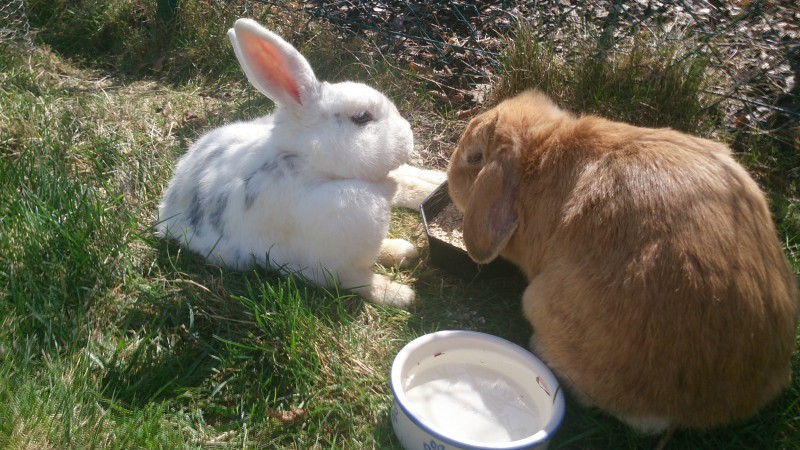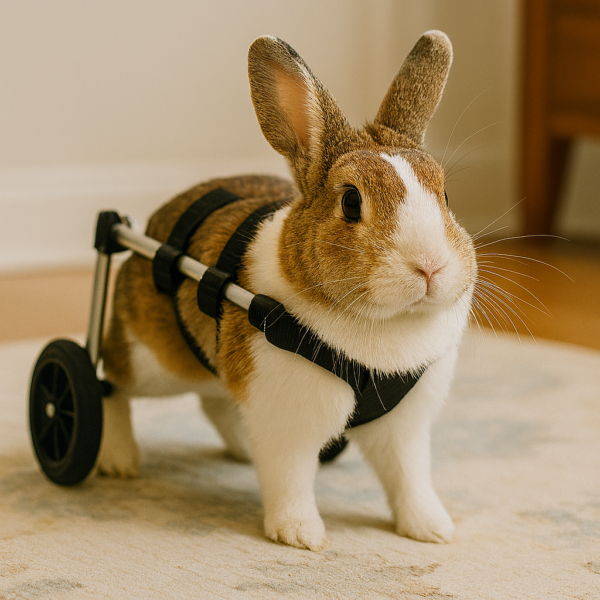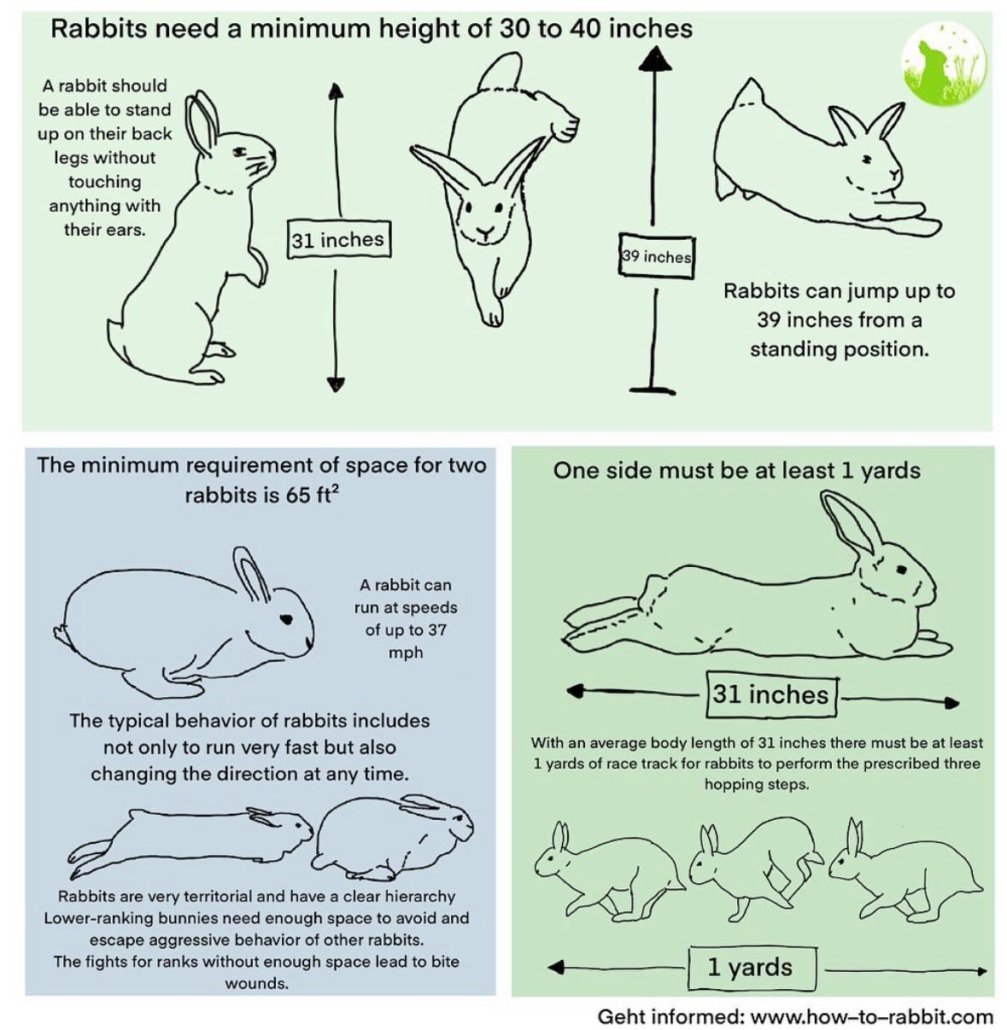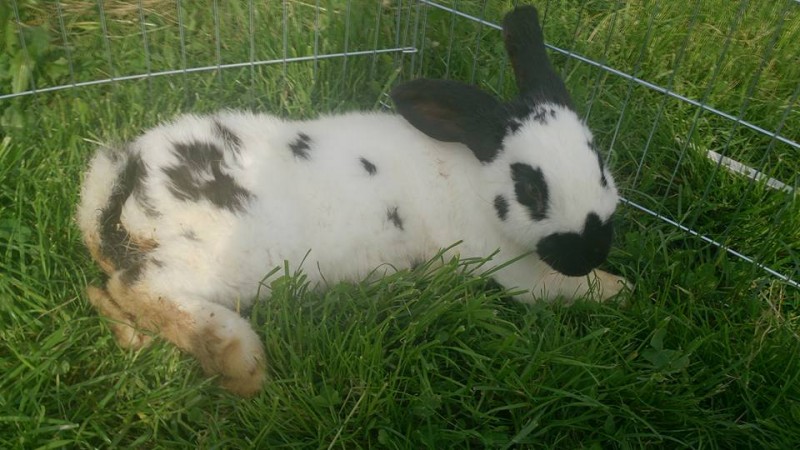When can a wheelchair be useful?
In rabbit breeding and care, it sometimes happens that an animal, due to neurological disorders, E. cuniculi, injuries, or congenital malformations, can no longer hop with its hind legs—or only does so to a limited extent. In such cases, mobility aids —commonly referred to as “carts” or “wheelchairs”— are sometimes used to help the rabbit move actively again.

Such a solution can be useful when:
- the animal can move on its own without the wheelchair but cannot hop, for example, it drags itself along on a non-slip surface. Especially younger animals with more severe hind leg impairments often compensate by developing very strong front leg muscles, which allows them to move fairly well (see more on how such animals should be kept and positioned); or
- the animal suffers from a condition that temporarily prevents movement, but the veterinary prognosis indicates a significant improvement with treatment;
- a veterinarian has confirmed that the animal is not in pain; and
- the person responsible for care is willing to provide the intensive attention and supervision required.


Attention: Painful conditions
Rabbits do not show pain. It’s not easy for us to notice — they still appear active, eat, and do their best to adapt, because they have no other choice. However, many illnesses cause deep and severe pain, to the point that even painkillers cannot provide adequate relief.
A clear example is spinal fractures, which cause extreme and incurable suffering. Keeping an animal with an irreversible condition alive —one without any hope of recovery and with pain that cannot be eased— is not an act of kindness, but a prolongation of its suffering.Can the rabbit move on its own, or does it have a realistic chance of recovery or improvement?
If neither condition is met, then a dignified life is no longer possible.
A rabbit with such a severe disability cannot have constant human assistance — no one is there every moment to bring it food or water, to take it out of its cart when it wants to rest, or to help it move when it wishes to.Even with the most devoted care —allowing it to move for hours in its wheelchair and giving it all our affection— it will spend the nights lying in its own waste, unable to reach food or water, or move when it needs to.
That is not a dignified life.
Important limits and risks

It is essential to keep the following in mind:
- Greatly reduced freedom: A rabbit using a cart can no longer freely decide whether to lie down, crawl, or flee — behaviors that are natural to it.
- Hygiene and elimination control: Paralysis or limited mobility can make it difficult for the rabbit to clean itself, scratch, or control when and where it relieves itself. This can lead to skin irritation, urinary infections, or other health problems.
- Psychological stress: When an animal cannot fulfill its natural behaviors of movement, protection, and escape, it experiences high levels of distress and emotional strain.
- Basic animal welfare needs: A key criterion for proper care is that the animal can express most of its natural behaviors — move freely, live in a social environment, and have space for shelter or escape. If this is not permanently possible, its actual well-being must be seriously questioned.

Opportunities and advantages
A cart can also offer certain benefits:
- Possibility of movement: With the help of wheels, the rabbit can move actively again and satisfy, at least partially, its natural need for activity.
- Improved quality of life: If it regains some mobility, its physical and emotional well-being can improve significantly.
- Psychological aspects: An animal that can move again often shows more interest in its surroundings, eats better, and interacts more with other rabbits or with people.

Practical considerations
- Comprehensive veterinary assessment: Before acquiring or using a cart, a thorough evaluation —neurological, orthopedic, and pain-related— must be carried out. In almost all cases, diagnostic imaging (such as CT or MRI scans) is necessary to determine whether the animal is in pain and to identify its cause.
- Individually fitted cart: The cart must be custom-made to match the rabbit’s size, weight, and body structure, allowing it to stand and move comfortably without strain or unnatural posture.
- Suitable surface and environment: A non-slip floor and sufficient space are essential so the rabbit can move safely. All obstacles in the movement area should be removed.
- Constant care and supervision: Supports or diapers must be changed frequently; the skin and urinary system should be checked regularly, along with posture, hygiene, and mobility.
- Physiotherapy: A complementary physiotherapy program is often very beneficial to maintain muscle mass and stimulate circulation.
- Stimulation and companionship: Despite physical limitations, the rabbit should remain mentally stimulated and in contact with other rabbits. Companions with similar disabilities or older rabbits are often ideal to prevent conflict or bullying.
- Rest periods: The animal also needs time for rest and comfort. Keeping it permanently in the cart, without allowing it to lie down or relax freely, is not an appropriate option.



Surgery after a fracture — the rabbit can move very well on three legs.


Conclusion – A guide for decision-making
A wheelchair or cart for rabbits can be a valuable aid in certain circumstances, but it should not obscure the fact that the limitations remain considerable. The key is to assess honestly the following:
- Can the rabbit, despite its mobility limitations, still perform most of its natural behaviors (moving, grooming, social interaction)?
- Can you realistically handle the effort required for its care, supervision, and environmental adaptation?
- Does the animal’s quality of life truly improve, or is its life merely being prolonged at the cost of significant suffering?
If the answer to these questions is negative, the most responsible choice may be palliative care or a compassionate farewell.
If the answer is positive, then—with the right combination of mobility aids, an adapted environment, and proper care—the rabbit can live a dignified and good-quality life, even with its limitations.

It is, without doubt, admirable when an owner devotes all their time, effort, and resources to helping their animal.
However, a true animal lover must also recognize the moment when, despite all the affection, dedication, and advances in modern medicine, a full life is no longer possible for their pet.A rabbit with complete paralysis will never again be able to meet most of its basic needs or express its natural behaviors — even less so than a rabbit confined to a cage — which results in deep suffering.
— Dr. Melina Klein, Veterinarian
Step-by-step support method

Step 1: Veterinary assessment
Before making any decision, a full veterinary evaluation is essential: determine the cause of the paralysis, check whether the animal feels pain, perform a neurological examination, and establish a clear prognosis.
Step 2: Choosing and fitting the cart
The cart must be custom-made according to the rabbit’s size, weight, and body structure.
- The frame should be stable, lightweight, and well balanced, allowing the rabbit to stand and move comfortably.
- The chest and hip harness or supports must be padded and prevent chafing.
- It is crucial to ensure that the rabbit can remain comfortable in the cart, with proper support for the thighs, groin, and legs without strain.
Step 3: Suitable environment and surfaces
- Choose a non-slip floor, such as mats with a non-slip base.
- Adapt the rabbit’s enclosure by removing steps or steep ramps.
- Provide resting and shelter areas where the rabbit can lie down without the cart, on a soft, cushioned surface.
- Place food and water at ground level, accessible without jumping or stretching.
- Maintain strict daily cleanliness of the environment, supports, and surfaces to prevent infections or irritation.
Step 4: Intensive care and constant supervision
- Frequently replace any materials or surfaces in contact with the animal, especially if soiled with urine or feces, to prevent skin or urinary infections.
- Regularly check the skin and joints for pressure sores, pododermatitis, or overuse injuries in the front legs.
- Ensure rest and relaxation periods — the rabbit should never stay in the cart continuously.
- Pay attention to its social and mental needs: rabbits with physical limitations ALWAYS need companionship, stimulation, and contact with other rabbits.

Step 5: Honestly evaluate quality of life
- Can the rabbit meet its basic needs — to move, groom, rest, and interact with others?
- Am I realistically able to commit to the ongoing care and effort required?
- Does the use of the cart truly improve its quality of life, or does it merely prolong a limited and painful existence?
If the answer to several of these questions is no, the most responsible and compassionate choice may be palliative care or a dignified farewell.
A message from the heart
Every rabbit deserves love, care, and a life that respects its nature.
But when a physical limitation appears, what truly matters is not just continuing to live — but continuing to live with quality and well-being.The wish to restore mobility comes from the heart, but the voice of reason must also be heard.
A technical aid can be a precious gift — yet it is not the right solution for every rabbit, nor for every condition.




















